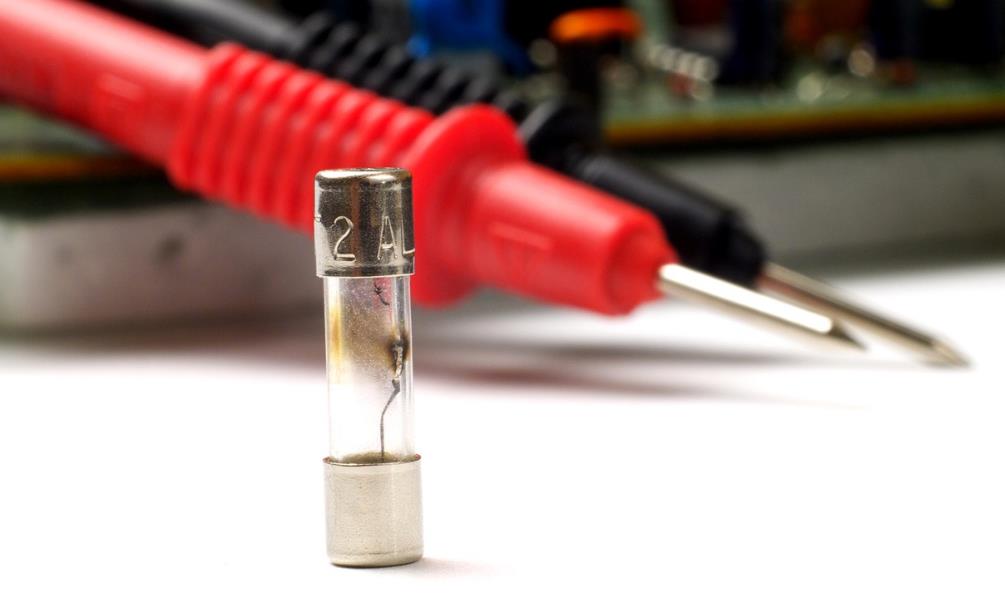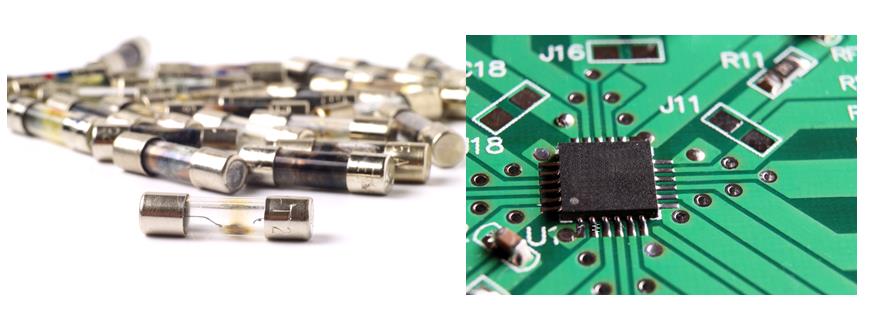TV를 살 때, 어느 브랜드의 제품인지는 중요한 선택지 중 하나다. 브랜드에는 제품의 신뢰성이 영향을 미친다. 다양한 제조사들이 서로 다른 품질 표준을 갖고 있기 때문에 비교적으로 고장이 잦은 브랜드가 있기 마련이다.
제품이 고장이 생기면 제조사도 수리하는데 시간과 비용을 들여야 한다. TV에서 문제가 된 고장 부품을 찾아서 교체하고 고장의 근본적인 원인을 기록하는 일은 상당한 시간과 원상 복구하는데 교체 비용과 인건비가 발생한다.
전자 시스템 고장 발생원인 중 하나는 입력 퓨즈
자체 복구 특성으로 '끊어지면' 자동으로 복구
TV를 살 때, 어느 브랜드의 제품인지는 중요한 선택지 중 하나다. 브랜드에는 제품의 신뢰성이 영향을 미친다. 다양한 제조사들이 서로 다른 품질 표준을 갖고 있기 때문에 비교적으로 고장이 잦은 브랜드가 있기 마련이다.
제품이 고장이 생기면 제조사도 수리하는데 시간과 비용을 들여야 한다. TV에서 문제가 된 고장 부품을 찾아서 교체하고 고장의 근본적인 원인을 기록하는 일은 상당한 시간과 원상 복구하는데 교체 비용과 인건비가 발생한다.

그림 1. 단선된 퓨즈는 교체 비용을 발생시킬 뿐 아니라 과부하 발생 시 추가적인 부품 손상을 초래해 또 다른 교체가 필요할 수 있다.
전자 시스템에서 고장이 발생하는 가장 흔한 부품 중 하나는 입력 퓨즈이다. TV에는 종종 기계식 퓨즈(또는 “용융 퓨즈”)가 사용된다. 제조사는 저렴한 가격을 이유로 더 비싼 다른 옵션 대신 시스템 보호를 위해 종종 기계식 퓨즈에 의존한다. 유감스럽게도 기계식 퓨즈는 고장이 나서 녹으면 손상되어 작동하지 않기 때문에 매번 물리적으로 교체해야 한다. 또한, 각각의 퓨즈는 전류 정격과 트립 포인트를 제공하므로 주의 깊게 보관하고 관리해야 한다.

그림 2. 회로를 보호하려면 단선된 퓨즈를 계속 교체하거나 회로 설계를 단일 eFuse로 업그레이드한다
기계식 퓨즈의 동작 특성은 eFuse라고 부르는 전자 퓨즈와 극명하게 대비된다. 그림 2의 TI TPS25921A와 같은 반도체 소자는 “자체 복구(self-healing)” 특성을 갖춰 퓨즈가 “끊어지면” 자동으로 다시 복구해 회로를 재구성 할 수 있다.
eFuse는 전류를 제한하고 출력 전압을 클램핑할 뿐 아니라 필요한 경우 eFuse의 출력에 공급되는 전력을 차단함으로써 과부하 발생을 감지하고 다운스트림 회로를 보호한다. 각각의 eFuse는 외부 저항과 함께 가변 전류 제한 설정을 제공하므로 기계식 퓨즈와 비교해 제조사가 비축해야 하는 고유 부품 번호를 줄일 수 있어 재고 관리가 간소해진다.
일부 eFuse는 외부 블로킹 FET(TPS25924)를 추가하거나 백-투-백(back-to-back) FET(TPS25940)를 통합하면 역 전류에 대해서도 보호할 수 있다. 간단히 말해 eFuse의 역할은 어떠한 과전류나 과전압 과도 상태에 대해서도 다운스트림 회로를 완벽하게 보호하도록 보장하는 것이다.
기계식 퓨즈에 비해 eFuse는 다운스트림 부품에 미치는 손상을 보다 효과적으로 방지한다. 기계식 퓨즈가 온도가 상승해 “녹는” 시간 동안, eFuse는 이미 회로를 보호한다. 이러한 시간 차이는 eFuse로 설계된 시스템은 일시적인 과전류나 과전압으로 인한 손상을 입지 않으며, 문제가 해결되면 정상 동작으로 복귀한다는 것을 의미한다. 반면 기계식 퓨즈로 설계된 동일한 시스템은 퓨즈가 끊어지면 교체를 위해 제조사에 반송해야 한다.
TV에 기계식 퓨즈 대신 eFuse를 사용한다면 제품 고장의 위험을 줄일 수 있다.